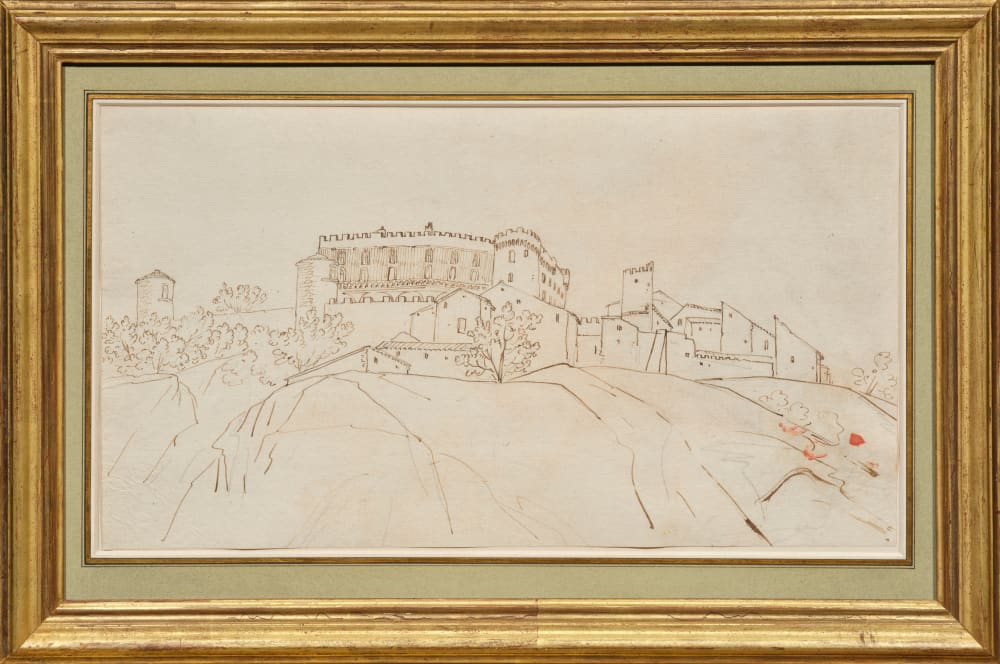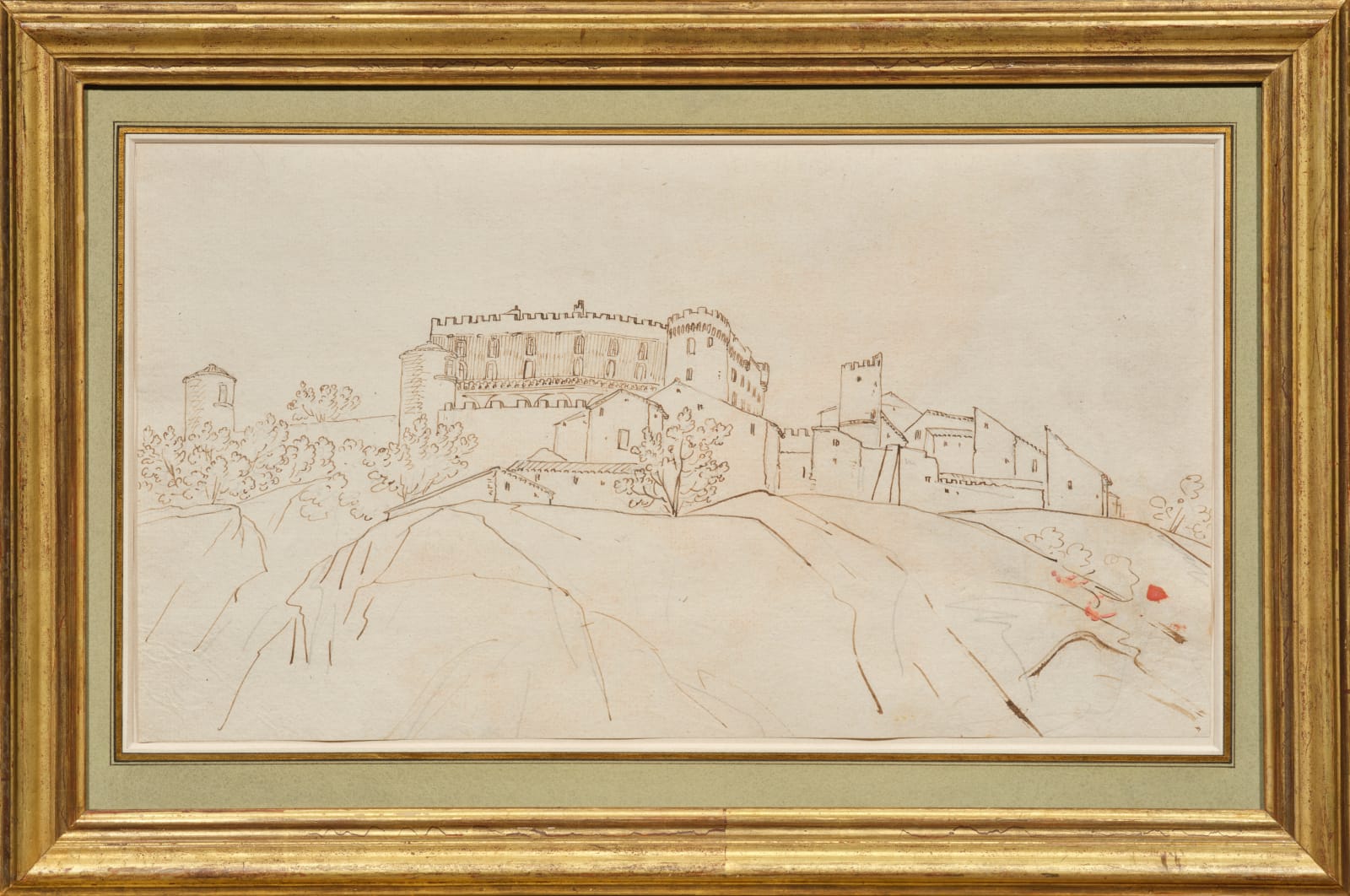 Claude-Joseph Vernet - Three Men around a large Stone (RF 33551) Musée du Louvre
Claude-Joseph Vernet - Three Men around a large Stone (RF 33551) Musée du Louvre
 Claude-Joseph Vernet - The Castello of Baia and Cape Misene - circa 1750 (22808) Albertina - Vienna
Claude-Joseph Vernet - The Castello of Baia and Cape Misene - circa 1750 (22808) Albertina - Vienna
Claude Joseph Vernet
22 x 39.5 cm
Further images
Madame Beck-Saiello kindly confirmed the authenticity of this drawing after an in-person examination./ Nous remercions Madame Beck-Saiello d’avoir confirmé le caractère autographe de ce dessin après un examen de visu.
It was probably during an excursion in the countryside near Avignon that Claude-Joseph Vernet executed this drawing, enhanced with pen and brown ink, depicting a mansion on a hilltop overlooking a small village with geometric shapes.
1. Joseph Vernet, a painter influenced by Italy
Claude-Joseph Vernet was born in Avignon in 1714, the son of Antoine Vernet (1689-1753), an artisan painter of architectural decorations, coach panels, and the like. He moved to the studio of Philippe Sauvan (1697-1792), a leading history painter in Avignon, and then worked with Jacques Viali (active 1681-1745), a decorative, landscape, and marine painter in Aix-en-Provence. Vernet's first recorded paintings were decorative overdoors executed in 1731 in the Aix townhouse of the marquise de Simiane. In 1734, Joseph de Seytres, marquis de Caumont, a leading amateur in Avignon, sponsored Vernet to make a study trip to Italy to complete his artistic education and to draw antiquities for his patron.
As Avignon was a papal territory in Vernet's day, he also had a number of useful introductions among influential churchmen when he arrived in Rome. Vernet was soon at home in the French community there, and he was encouraged by Nicolas Vleughels (1668-1737), director of the Académie de France in Rome, even though the young painter had no official affiliation with the royal institution. He likely entered the studio of the French marine painter Adrien Manglard (1695-1760). By 1740 Vernet was developing an independent reputation as a painter of topographical landscape in and around Rome and Naples, as well as of imaginary Italianate landscapes and marines, demonstrated by the increasing number of entries in his surviving account books from the mid-1730s onward. His first important patron in Rome was the French ambassador Paul Hippolyte de Beauvillier, duc de Saint-Aignan (1684-1776). This relationship set a pattern, and members of the French diplomatic corps and visiting French prelates remained important patrons during Vernet's long Roman sojourn, which lasted almost twenty years (he returned definitively to France in 1753). He also worked for the Roman nobility but it was the British - the wealthiest travelers in Europe - who became Vernet's main patrons during their Grand Tours, purchasing Italianate landscapes and marines as souvenirs of their visits to Italy. The British remained enthusiastic patrons of Vernet, even long after his return to France.
The appeal of Vernet's art was twofold. On the one hand, he drew on the tradition of ideal landscape painting codified by Claude Lorrain (1604/1605-1682) and Nicolas Poussin (1594-1665) in seventeenth-century Italy. Vernet, on the other hand, brought to the study of nature a more empirical and closely observed approach, consistent with his times, creating a more vivid and convincing impression of nature. Having established these kinds of paintings as successful formulas by the mid-1740s, Vernet continued to supply a European demand for them for the rest of his career.
Vernet first exhibited typical landscapes and marines at the Paris Salon of 1746, the year his membership in the Académie royale de peinture et de sculpture was approved. He became a full member in 1753 and exhibited successfully at the Salon for the rest of his life. He had come to the attention of Louis XV's administration in 1746, and in 1753 he was finally called back to France to begin an official commission to paint large topographical views of the principal commercial and military seaports of the realm. This commission took him on an arduous itinerary, from Antibes in the south to Dieppe in the north, from 1753 until 1765, during which time he completed fifteen large paintings. Vernet's "Ports of France" (Paris, Musée du Louvre on loan to the Musée de la Marine) are among the greatest French paintings of the mid-eighteenth century, for they are both remarkable social and historical documents, full of fascinating observation, and at the same time beautifully composed and rendered works of art.
Vernet continued a large production of imaginary landscape and marine paintings until his death on the eve of the French Revolution in 1789.
2. Description of the drawing
Our drawing was probably first executed by Claude-Joseph Vernet in pencil, working on the spot and in the open air, then retouched in pen and brown ink with a lively, regular stroke once he had returned to his studio. In all likelihood, it depicts a Provencal mansion, proudly perched on a hill overlooking a small village[1] . The absence of shadows in the landscape and the cloudless sky allow us to imagine the bright mid-day sun.
The artist pays particular attention to the representation of architectural details (battlements, machicolations at the top of the towers, etc.). He is sensitive to the articulation of the geometric volumes that make up the village houses below the castle, and to the contrast between these sharp angles and the roundness of the castle towers. The trees are soberly evoked by their foliage, a characteristic found in many of Vernet's landscape drawings.
Vernet remained faithful to the pen-and-pencil technique for his figure drawings, as can be seen, for example, in the drawing of Trois hommes autour d'une grosse pierre (Three Men around a large Stone) in the Musée du Louvre.
From the middle of his Italian sojourn, his landscape drawings were often enriched by delicate wash work, leading us to consider this drawing a youthful work, probably executed before his departure for Italy.
3. Framing
Our drawing is soberly framed in a gilded wooden moulding reminiscent of the pastel frames of the Louis XV period.
Main bibliographical references :
Léon Lagrange - Joseph Vernet - Didier & Cie 1864
Florence Ingersoll-Smouse - Joseph Vernet, Peintre de Marine - Etienne Bignou 1926
Catalog of the exhibition Joseph Vernet 1714 - 1789 - Musée de la Marine, Paris (October 15, 1976 - January 9, 1977)
Emilie Beck Saiello - Napoli e la Francia - I Pittori da paesaggio da Vernet a Valenciennes - L'erma di Bretschneider, Roma 2010
[1] Unfortunately, we have not been able to identify the location depicted in this drawing, which bears a strong resemblance to Grignan, and could therefore be another château in the region (perhaps Suze-la-Rousse ?).








